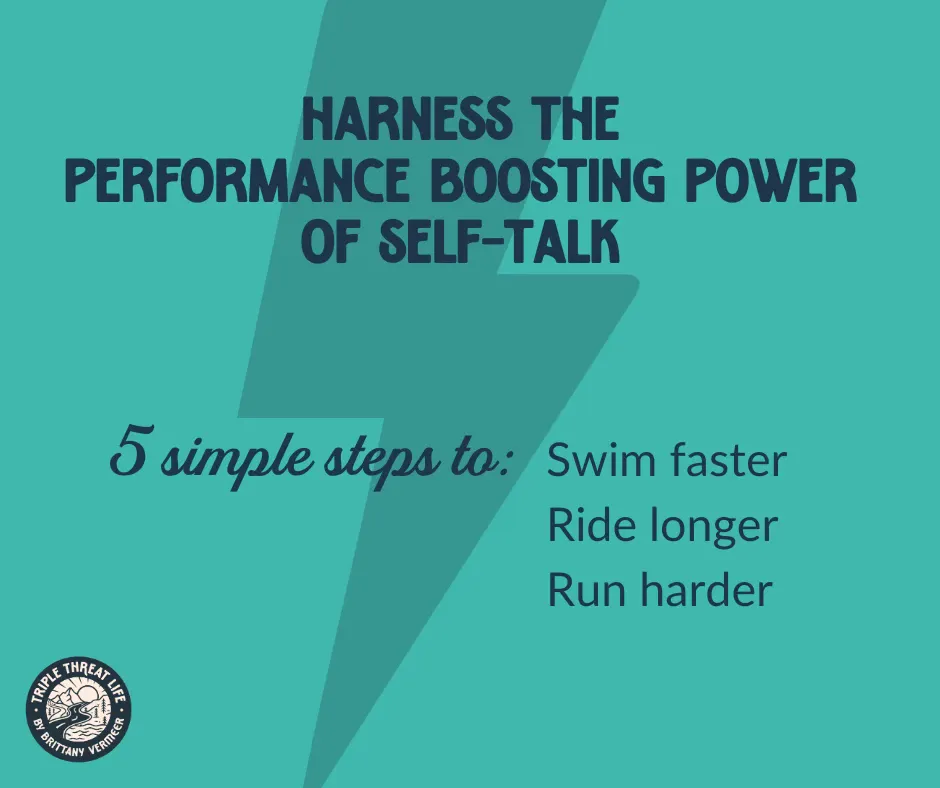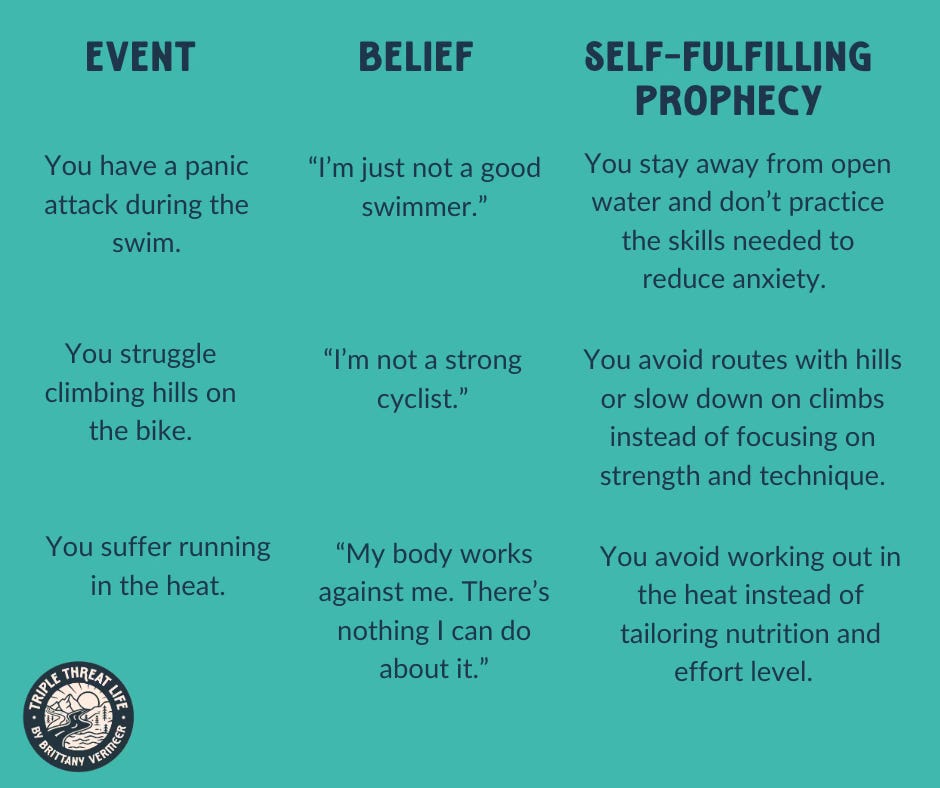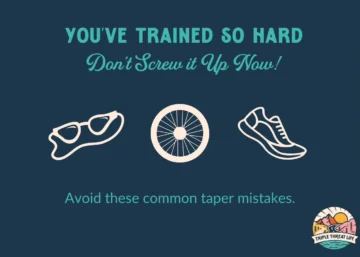
The words we say to ourselves matter, more than you might think.
New research has shown that positive self-talk isn’t just a way to increase confidence. It can have huge performance boosting benefits as well.
But the key isn’t just what we say, but how we say it.
Misconceptions about self-talk
I think the reason why some athletes shy away from using self-talk is because they think it’s all sunshine and rainbows- just something to make you feel warm and fuzzy inside. But that’s not it at all.
When you make mistake during a race, you probably don’t feel very positive. You don’t want to tell yourself how great you are, because you know that you messed up and want to correct those mistakes.
Certainly, some self-talk can be motivational with positive phrases that improve confidence.
“I can do this!”
“One step at a time.”
“I trust in my abilities and my training.”
But there’s also instructional self-talk, which includes verbal cues like:
“Quick feet, relax your shoulders.”
“Focus on what you’re doing right now.”
“Take long smooth strokes.”
But recent research has gone even deeper- starting to look not only at what we say, but how we say it. Studies have shown that referring to yourself as “you” instead of “I” has a huge impact on the effectiveness of self-talk.
Example: Think about the difference in meaning between these two sentences:
“I can do this!”
“You can do this!”
The idea behind using the second person pronoun, “you,” creates a sense of psychological distance between yourself and the challenging situation. It sounds more like something a coach or friend might say, which provides an external perspective.
Instead of: “I feel strong, powerful, and will attack this course.”
Try: “You feel strong, powerful, and will attack this course.”
It probably seems like a small change, but this subconscious shift can help a lot when doubts start to creep in during a hard workout or towards the end of a race.
Essentially, it’s all about changing your emotional response to an experience.
Performance boosting benefits
So you might be willing to acknowledge that self-talk is helpful, but you’re probably still skeptical about its performance-boosting benefits.
I mean, words can’t help us swim faster, ride longer, and run harder…
Oh, but they can.
In one study, researchers had 24 cyclists ride at 80% of peak power during a time trial in order to establish a baseline. Then, over the next two weeks, 50% of the cyclists were trained in positive self-talk.
When they did the time trial the second time around, the self-talk group lasted an average of 18% longer- almost 2 minutes more than the first trial!
That’s an incredible increase, and it was achieved by something as simple as speaking the right words.
Another study showed that runners who were trained in psychological skills were able to run 8% farther during a 90 min. max effort run in the heat. Techniques used included: goal-setting, relaxation techniques, mental imagery, and positive self-talk.
In addition to physical performance benefits, self-talk can have a huge impact on focus and concentration.
If you watched the women’s all around gymnastics competition at the Olympics, you might have seen Simone Biles whisper to herself, “You got this. It’s your time,”moments before doing the beam routine that helped her win all-around gold.
That’s the power of positive self-talk at work.
Don’t let negative self-talk turn into a self-fulfilling prophecy
Think about the words you use to describe your abilities as an athlete.
Do you say things like:
- “I’m just not a good swimmer.”
- “I’m a slow cyclist.”
- “I’m not a very good runner.”
You might think, I’m just being realistic. I know what my limits are.
But the problem is that your beliefs about your abilities are influenced by your emotions, and that perception might not be accurate at all. If you’re not careful, negative self-talk can turn into a self-fulling prophecy.

Instead, reframe those thoughts. It’s fine to acknowledge areas for growth, but do it in a more positive way.
- “Swimming is a challenge for me, but I’m working hard to develop good form.”
- “I have excellent endurance on the bike and will continue working to increase speed.”
- “I’m seeing consistent improvements in my running and will keep at it.”
5 Steps for using Positive Self-Talk
- Identify the negative– First, you have to identify the negative self-talk, thoughts, or beliefs that are holding you back. Make a list and write them down.
- Reframe to positive– Next, determine how you can reframe the negative self-talk into positive statements. The goal is to flip the switch from the negative to a focus on positivity, confidence, and growth.
- Reprogram with repetition– Repeat these positive phrases to yourself daily. We don’t get better at anything without practicing, and the same is true with training our mental muscles.
- Create a “pattern breaking” phrase– This is a phrase you will use when negative thoughts start to creep back in. Think of it as a STOP sign that interrupts the unhelpful thoughts. A common phrase I use is “Refocus.”
- Use verbal cues– I come up with a verbal cue for the swim, bike, and run. Examples might be “Long, smooth strokes” or “Engage glutes, drive forward.”Then, I practice using them during training. Repetition matters, because you want the movement associated with the phrase to become automatic.
Suggested Reading:
If you like this topic, here are two of my favorite books.
- The Genius of Athletes by Dr. Noel Brick. He explains how we can use the same techniques as elite athletes to improve performance. He provides examples of how legendary marathoner, Meb Keflezighi, uses self-talk during races and how Michael Phelps used “if-then planning” to win a gold medal at the Olympics.
- Endure: Mind, Body, and the Curiously Elastic Limits of Human Performance by Alex Hutchinson. It will change the way you think about yourself and your perceived physical limits. Perhaps you’re capable of far more than you think…
Question of the Day:
Submit your question and I’ll answer it in an upcoming newsletter.
Scott– “How do you know when to change the cleats on your cycling shoes?”
Brittany– We change ours when the rubber bumper on the bottom gets worn down, if the plastic starts to fray, or if your cleats stick in your pedals. But it’s very important to make sure you put the cleats back on in the same position to avoid messing with your pedal stroke, which can contribute to keen and hip pain. Also, be sure to select the right type of cleat. I use Look KEO gray, which have 4.5 degree float (the amount of play back and forth). I made a video explaining how to change your cleats. All you need is a Sharpie and a hex key.


